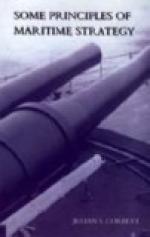It would seem, therefore, that it were better to lay aside the designation “offensive and defensive” altogether and substitute the terms “positive and negative.” But here again we are confronted with a difficulty. There have been many wars in which positive methods have been used all through to secure a negative end, and such wars will not sit easily in either class. For instance, in the War of Spanish Succession our object was mainly to prevent the Mediterranean becoming a French lake by the union of the French and Spanish crowns, but the method by which we succeeded in achieving our end was to seize the naval positions of Gibraltar and Minorca, and so in practice our method was positive. Again, in the late Russo-Japanese War the main object of Japan was to prevent Korea being absorbed by Russia. That aim was preventive and negative. But the only effective way of securing her aim was to take Korea herself, and so for her the war was in practice positive.
On the other hand, we cannot shut our eyes to the fact that in the majority of wars the side with the positive object has acted generally on the offensive and the other generally on the defensive. Unpractical therefore as the distinction seems to be, it is impossible to dismiss it without inquiring why this was so, and it is in this inquiry that the practical results of the classification will be found to lie—that is, it forces us to analyse the comparative advantages of offence and defence. A clear apprehension of their relative possibilities is the corner stone of strategical study.
Now the advantages of the offensive are patent and admitted. It is only the offensive that can produce positive results, while the strength and energy which are born of the moral stimulation of attack are of a practical value that outweighs almost every other consideration. Every man of spirit would desire to use the offensive whether his object were positive or negative, and yet there are a number of cases in which some of the most energetic masters of war have chosen the defensive, and chosen with success. They have chosen it when they have found themselves inferior in physical force to their enemy, and when they believed that no amount of aggressive spirit could redress that inferiority.




